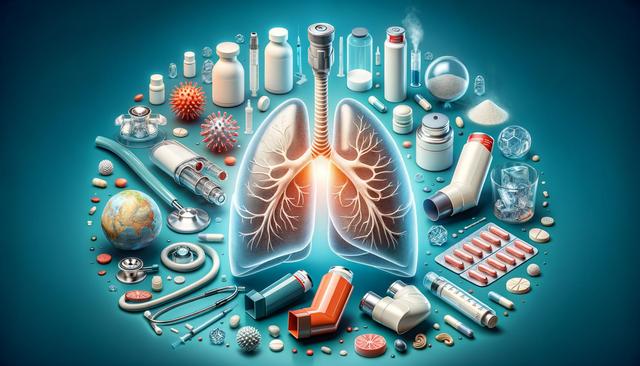Understanding COPD and the Need for Effective Treatment
Chronic Obstructive Pulmonary Disease (COPD) is a progressive lung condition that affects millions of individuals worldwide. It is primarily caused by long-term exposure to irritating gases or particulate matter, most often from cigarette smoke. The disease is characterized by increasing breathlessness, chronic cough, and frequent respiratory infections. As COPD progresses, it can significantly reduce quality of life and limit daily activities. Given its chronic nature, managing COPD requires a comprehensive approach that focuses on symptom control, slowing disease progression, and improving overall lung function. Advances in treatment strategies have made it possible to tailor therapy more closely to individual patient needs, especially as new therapies emerge in 2025.
Pharmacological Therapies: Inhalers, Bronchodilators, and Beyond
Medications remain a cornerstone of COPD management. Inhalers, particularly those that deliver bronchodilators and corticosteroids, are commonly used to reduce inflammation and open airways. Long-acting beta-agonists (LABAs) and long-acting muscarinic antagonists (LAMAs) are often prescribed individually or in combination to maximize bronchodilation. Inhaled corticosteroids (ICS) may be added for patients with frequent exacerbations.
Newer drug formulations and delivery devices introduced in 2025 have shown improved drug deposition in the lungs and better patient adherence. Some of the latest pharmacological approaches include:
- Triple combination inhalers that simplify treatment regimens.
- Biologic therapies targeting specific inflammatory pathways.
- Personalized dosing strategies based on biomarker profiling.
These innovations aim to improve outcomes by reducing exacerbations, enhancing lung function, and minimizing side effects.
Non-Pharmacological Interventions: Pulmonary Rehabilitation and Lifestyle Changes
While medications are essential, non-pharmacological interventions play a significant role in comprehensive COPD care. Pulmonary rehabilitation is a structured program that combines exercise training, nutritional counseling, and education to help patients manage their condition more effectively. It has been shown to improve exercise capacity, reduce symptoms, and enhance quality of life.
Key components of successful non-pharmacological management include:
- Regular physical activity tailored to individual capability.
- Smoking cessation support and nicotine replacement therapies.
- Dietary modifications to prevent malnutrition or obesity.
- Psychological support and mental health services.
These interventions not only contribute to better disease control but also empower patients to take a more active role in their health management.
Emerging Technologies and Digital Health Solutions
Technological innovation continues to shape the management of chronic diseases, and COPD is no exception. In 2025, digital health tools have become increasingly integrated into COPD care, offering both patients and providers new ways to monitor and manage the condition. Remote monitoring devices can track oxygen levels, respiratory rate, and inhaler usage in real-time, allowing for earlier detection of exacerbations.
Notable technological advancements include:
- Wearable sensors that provide continuous respiratory monitoring.
- Smart inhalers with adherence tracking and usage reminders.
- Mobile applications for symptom logging and teleconsultations.
- AI-driven platforms that analyze patient data to predict flare-ups.
These technologies offer the potential to reduce hospitalizations and emergency visits by enabling proactive and personalized care.
Innovative Therapies and Future Outlook
Innovative therapies continue to emerge, offering new hope for individuals living with COPD. In 2025, researchers are focusing on regenerative medicine, gene therapy, and novel anti-inflammatory agents to target the underlying mechanisms of COPD. Although many of these treatments remain under clinical evaluation, early results are promising.
Some of the most promising developments include:
- Stem cell therapies aimed at lung tissue regeneration.
- Gene editing techniques designed to repair damaged lung cells.
- New anti-inflammatory drugs that target specific immune responses.
- Vaccines developed to prevent respiratory infections that exacerbate COPD.
While these treatments are not yet widely available, they represent a shift toward disease modification rather than symptom control alone. As clinical trials advance, these therapies could redefine the standard of care for COPD in the future.
Conclusion: A Comprehensive Approach for Better Outcomes
Managing COPD effectively in 2025 involves a multifaceted strategy that combines pharmacological treatments, lifestyle interventions, and emerging technologies. With ongoing research and innovation, healthcare providers are now better equipped to offer personalized care that addresses the unique needs of each patient. Whether through advanced inhaler therapies, pulmonary rehabilitation, or digital health solutions, the goal remains the same: to enhance quality of life and slow disease progression. For patients and caregivers, staying informed about the latest treatment options and actively participating in care decisions can lead to more meaningful and sustainable health outcomes.







